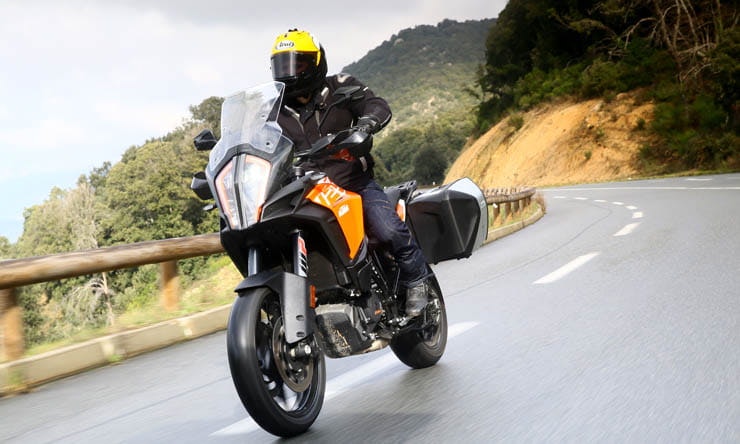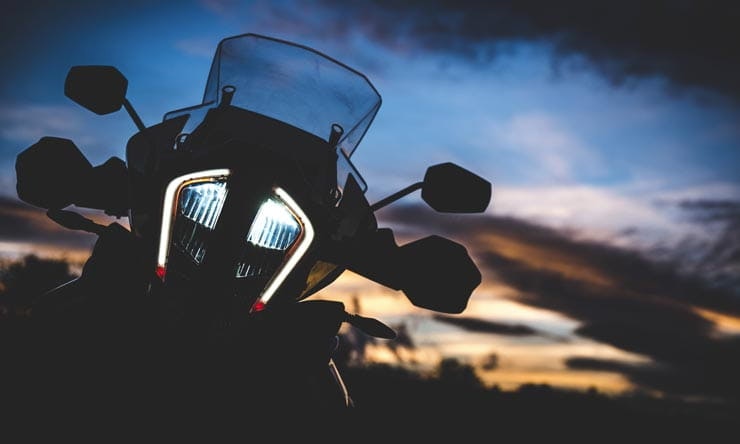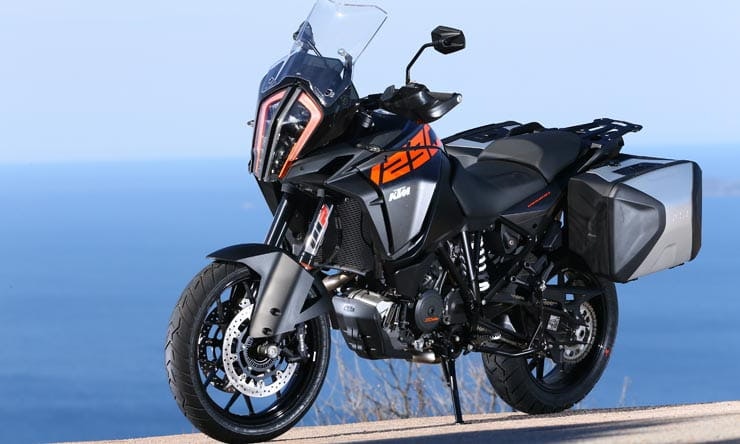I’m going to talk about cars for a second, but bear with me. A couple of months ago I was reading a piece about Group B rally cars in a well known car magazine. If you do a quick Google image search, you’ll find endless amounts of fantastic imagery of 1980s rally cars covered in headlights, often completely sideways, looking rather impressively out of control. You might notice, though, that the photography doesn’t get any more recent than the mid 1980s, and that’s because Group B came to a tragic end when Henri Toivonen and his co-driver lost their lives to an accident during the 1986 Tour de Corse. After that Group B was ruled too dangerous, and Audi even pulled out completely. The roads in Corsica have a bit of a reputation, and rightly so - they are as breathtaking and rewarding as they are dangerous. I filed Corsica away in my brain somewhere as a place that might be an interesting place to go riding one day. Carefully, of course.
Then, as luck would have it, last month an invitation to the launch of KTM’s updated for 2017, 1290 Super Adventure S landed. Where? In Corsica, of all places. A mixture of trepidation and excitement came over me, for reasons you, dear reader, can no doubt now imagine: Adventure Bike. 160bhp. Crazy roads. Invitation accepted!
Times are good for KTM right now. According to their UK PR team, the Austrian firm has just enjoyed its sixth “record breaking” year in a row, and is now able to claim that between its two brands, KTM and Husqvarna, that it occupies the position of Europe’s biggest manufacturer by volume with over 200,000 bikes shipped per year. Avid MotoGP fans will no doubt be aware that the upcoming 2017 season sees KTM step up as a contender in both the premier class and Moto2, meaning it’ll be competing across all three classes. As if that wasn’t enough to brag about, it just won its 16th Dakar in a row - with a Brit, Sam Sunderland, as the winning rider. Clearly a lot is going very, very right in Mattighofen (the M in KTM) at the moment.
On the back of all this success, KTM has ploughed some 140 million Euros into its R&D department and the result of that is a slew of new models and existing model updates - among them, the 1290 Super Adventure series. The Adventure line is very important to KTM, with 75,000 units sold since its introduction in 2003, and the 1290 Super Adventure sits at the top of the tree. Compared to last year, there are three new 1290 Super Adventure models in total, the S, R and T. The 1290 Super Adventure T is what was formerly known as the 1290 Super Adventure and starts at a base price of £15,499. The 1290 Super Adventure R is the ‘more off-roady’ version, starting at £14,499 and the S, the model I rode, is the ‘sporty road-going’ model which retains its name, available from £14,299.
What’s new?
From a fair distance, the 1290 Super Adventure S appears mostly the same as the outgoing 1290 Super Adventure S. It still has the utterly ballistic 160 HP, v-twin 1301cc motor borrowed from the maniac 1290 SuperDuke. It still has semi active suspension, cornering ABS and lean sensitive traction control, as well as all of the rider modes from the outgoing model.
But get a bit closer and the differences start to become much more apparent. It’s impossible not to notice the new 6.5” TFT display, developed in collaboration with Bosch, that replaces the LCD and analogue clocks on the outgoing model. It’s operated via a set of four-way controls on the left handlebar which illuminate at night. The display is also angle adjustable via a tab below the display in case it catches the sun at exactly the right angle to turn it into a mirror, and the display itself is finished with scratch and glare resistant Gorilla Glass that is found on many smart phones.
The ignition switch has been removed and in its place is installed a keyless system, enabling the bike to be turned on and started as long as the key is in close proximity to the bike. The fuel cap will unlock itself for 60 seconds after the engine is stopped, and there’s a waterproof phone pocket with an integrated USB socket, too.
New also is the LED headlight unit with its built-in lean sensitive array of cornering lights. It’s the same system as found on the SuperDuke GT which lights up more and more as the bike leans, except it’s packaged into the main headlight unit rather than as a set of auxiliary lights mounted to the fairing. KTM’s engineers took particular care to highlight this clever bit of kit thoroughly during the press briefing because it’s actually a piece of engineering genius. The metal ridge running down the centre of the headlight unit is not just aesthetic; it also provides a solution to a very real problem. A question was put to the journalists on the launch as to what we all thought it was for - but the electronics nerd in me already knew the answer - it’s a heatsink! Unlike incandescent bulbs, LEDs don’t generate heat themselves - but the MOSFET semiconductors which drive them do, and lots and lots of it, which all has to be dissipated somehow. Placing a heatsink inside the bike where it receives next to no airflow would be inefficient at best and potentially dangerous at worst, so where better to place a heatsink than directly exposed on the front of the bike? There it gets plenty of cool air flow and even rain… and looks good in the process. Neat.
Like most bikes which are new, updated or otherwise relaunched for 2017, the motor is now Euro4 compliant. Thankfully it hasn’t been strangled in the process unlike many other bikes similarly updated to comply with this piece of legislation. It still makes exactly the same power and torque as the outgoing model - 160bhp and 103lb-ft - and is still a ripsnorting beast of a thing, but more on that later.
The windshield has also received attention. It’s adjustable by hand and can be adjusted on the move. Unlike on the outgoing model, all it takes is a reach over the bars and turn of a dial to adjust it - there are no locking levers any more, and there’s a dial on each side of the shield just behind the TFT display for convenience both on and off the bike.
A raft of behind-the-scenes changes have also been worked into the entire 1290 Super Adventure range. Working from customer feedback on mouldy air filters, the air box now features a series of chambers on the snorkel which help to collect water and other debris before they have chance to make their way into the filter. The panniers are now mounted to a ‘floating’ system which helps to reduce vibrations and buffeting from being transferred to the chassis. If you’ve ever spent time on or around a Triumph Sprint 1050, it’s essentially an identical system and is known to work well.
Design, comfort and performance
While the 1290 Super Adventure S is an adventure bike by name and physical stature, KTM envisage owners will spend 99.99% of their time on the road, with the odd gravel track being the most off-road action that bike and rider will ever encounter - that’s why it’s got cast wheels rather than spoked rims, and it’s all the better for it.
With road usage in mind, let’s talk about performance. I’ll cut to the chase - the motor is absolutely ridiculous. To quote a KTM engineer present, “you may not need 160bhp in an adventure bike, but it sure is a lot of fun”. And he isn’t wrong.
In sport mode, where I spent most of my time, the semi-active suspension behaves more like a conventional suspension setup - it dives when the front brakes are applied. Throttle response is the most direct and traction control is set to its most lenient level. KTM had fitted the "Travel Pack" which includes, among other things, a quickshifter which works both up and down the 'box - it's super smooth and a pleasure to use. It’s so easy in Sport mode to forget this is a large, 250kg (fully fuelled) adventure bike as you blip between gears, dart into corners and use all of the grunt to fire out the other side - it shouldn’t be so willing, and yet it just is.
By 3,000 rpm the motor is already making over 73lb-ft of torque, which gives the feeling that there is torque everywhere in the rev range, and there absolutely is. But it’s not all about the motor. The chassis works with the suspension to handle it well, and it doesn’t tie itself in knots trying to keep the motor’s antics at bay. The wide bars and commanding riding position help to mask the weight of the bike, but you can still feel it at times.
Of course, in sport mode with some spirited riding, fuel economy takes a bit of a hit. I averaged 42mpg through a range of different conditions during the course of the day, which puts the 23 litre tank’s range at around 210 miles, although if you’re munching motorway miles on your best behaviour, you might see a few more.
Adjusting the bike back to Street mode for slightly more sensible riding changes a couple of things. Throttle response is reduced slightly but the semi-active suspension is given free reign to do its thing. In this mode, it’ll constantly read the road and adjust automatically as it detects changes in surface conditions. Cruising is a breeze, and cruise control is intuitive and easy to activate. The semi active suspension does reduce the communication coming back from the tyres and chassis somewhat, especially from the front end as fork dive is all but removed, but it does replace it with a feeling of an incredibly solid, sure-footed ride. I definitely can’t claim to have noticed every single micro-change the bike’s brain was making (except for the damping on the forks) but all day long the 1290 felt unruffled and confident no matter what the road conditions were. Via the TFT display, rear shock preload can be set between solo, solo with luggage, pillion and pillion with luggage.
And speaking of road conditions, we encountered them all. Corsica really did live up to its reputation, and then some. The route had everything from incredibly tight first gear switch backs with sheer drops on the other side, to tree-lined, root-rutted single-track roads with patches of tarmac missing, to sections of D-road which gave most of us motion sickness from the never-ending corners. All the while, the lean sensitive cornering ABS and traction control had my back and only once did I feel the rear tyre squirming for grip as the bike adjusted power from what I thought I wanted, to what I really only needed. So good is the cornering ABS and traction control that brakes can be applied far too deep into a corner and it all just gets shrugged off as if that’s how it’s supposed to be ridden.
In the afternoon conditions changed for the worse - full on torrential rain - a convenient excuse to slip into Rain mode. Here you’ve still got full power, but a drastically reduced and very linear throttle response with ABS and traction control set to intervene as early as possible.
It’s worth mentioning the forth and final mode - offroad. Although I didn’t get to try it, in this mode the rear wheel is allowed a fair amount of spin and can also be locked with the rear brake.
The Scorpion Trail II tyres handled everything which was thrown at them from rain to fistfuls of throttle with aplomb, although I imagine if ridden hard, tyre life will be limited - but that will be a problem for any tyre dealing with this much power.
Comfort on the big KTM is exactly as you’d expect. Almost everything is adjustable, from foot pegs to handlebar positions to gear lever positions to seat heights. The rider is sat in a dominating position with plenty of leverage over the pegs and handlebars. I detected absolutely zero buffeting from the windscreen in any height setting, and while we certainly did not reach truly silly speeds on Corsica’s infamous roads, the panniers did not make their presence known.
The design of the TFT display is well thought out, and possibly the best I’ve used to date. It’s immediately obvious how to use it using the controls on the handle bar, and everything is displayed clearly in a logical manner. Most crucially, the viewing angle is good, which is important on a bike you’ll move around a lot on.
Obviously there is a huge catalogue of accessories and add-ons for the 1290 Super Adventure range. As mentioned previously, KTM had installed their “Travel Pack” (available for an extra £585.40) on the bike I rode which includes a quick shifter (which works both up and down the ‘box), MSR (Motor Slip Regulation) which opens the throttle on your behalf on aggressive downshifts to prevent the rear wheel from locking, as well as hill-hold Control and something called “KTM MY RIDE” which allows you to tether your smart phone to the bike to take calls and control audio.
Is there anything which narked me about the 1290 Super Adventure S? Yes, there was, and that’s the lack of feedback when activating the bike via the ‘on’ button. There’s a delay between pressing the button and the display firing into life. This becomes confusing prompting another press of the ‘on’ button, which then turns the bike off - again with no feedback. And then the cycle continues, in an endless state of “is it on? is it off? is it even listening?”. This caught out a number of journalists as well as the KTM engineers present. With time, I’m sure they’ll work it out, and any owners will get the knack before long anyway.
Verdict
The 1290 Super Adventure S is very obviously an incredibly capable bike, and with the Travel Pack fitted for the excellent up-and-down quickshifter and Motor Slip Regulation, will leave you struggling to want for much else. About the only feature I can think of that it doesn’t have is launch control, and suffice to say, it wouldn’t see any use even if it did. The motor packs an incredible punch and the electronic sophistication will leave you wondering whether you’re riding it or just a passenger. It’s an utterly fantastic machine, capable of holding its own in twisties to transporting two people with luggage in relative luxury across continents to just popping to the shops
Anyone considering a 1290 Super Adventure S will no doubt also be looking at BMW’s R1200 GS Adventure and Ducati’s Multistrada 1200 S, and I suspect the choice will come down to a matter of personal taste as all three can be specced to near identical levels. The BMW doesn’t have cornering headlights available, and the Ducati doesn’t have an option for an up-and-down quickshifter. Some might favour the BMW for its shaft drive, and some might favour the KTM or Ducati simply for the extra grunt, choosing to look past their chain final drives. Other than that, there’s nothing else in it, except for how much damage they’ll each do to your wallet.
The 1290 Super Adventure S's price as ridden with the "Travel Pack" and touring cases comes to £15,715. The BMW R1200 GS Adventure starts at £13,500 but requires a further £2,700 throwing at it, bringing the total to £16,200, in order to get to the same specification level as the KTM - but you'll still be 35 horsepower short of the KTM and Ducati. The Ducati will set you back a whopping £15,575 but comes out of the crate at almost the same level of specification as the KTM with the "Travel Pack" fitted, requiring only the "Touring Pack" to be lifted from Ducati's accessories catalogue for a further £895, bringing the total to £16,490. So, all in all, there's perhaps £775 between the three.
So what would make me buy the KTM over the competition? The answer is simple - that motor, the brilliant 6.5” display, and the fact it's incredible value for money.
Rich Taylor
Share on social media:


